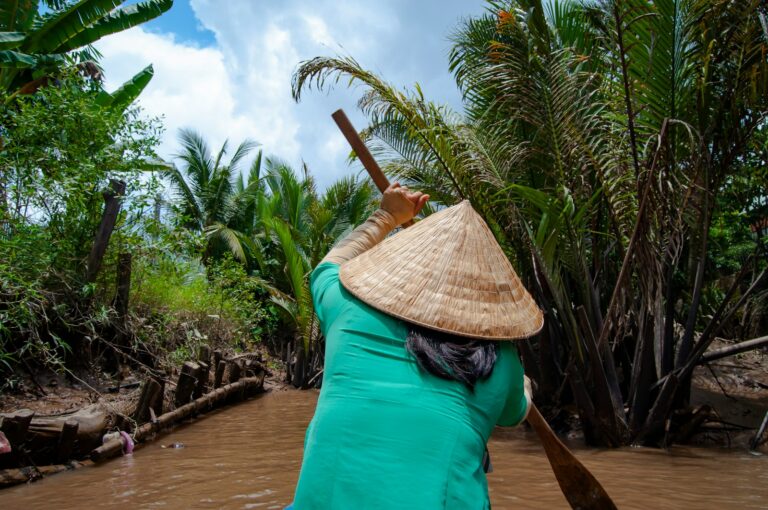Sip by Sip, Saigon Embraces the West
Global coffee chains like Starbucks and Coffee Bean are reshaping the café culture of Vietnam’s busiest city—where tradition meets trend, and a cup of coffee says more than you think.
Western coffee shops are reshaping Saigon’s café culture, one stylish sip at a time.
On a steamy Sunday morning in Ho Chi Minh City, the scent of roasted beans and motorbike exhaust already filled the air before the sun climbed over the skyline. I was standing at the end of a long, snaking line outside the brand-new Starbucks at the New World Hotel on Lê Lai Street—a gleaming glass box wedged into one of Vietnam’s most caffeine-obsessed corners.
This wasn’t about getting a quick caffeine fix. By 9 a.m., the line stretched five meters deep. Inside, another queue wound past polished counters and latte machines. And this wasn’t even opening day. That had happened a few days earlier, when the line reportedly reached ten meters and people were hopping out of rideshare cars just to join it. In a city that has long worshipped coffee, this wasn’t about the beverage. It was about the moment—the statement of arriving early to a global trend, now with a Vietnamese address.
As expected, parking was chaotic. The hotel’s adjacent lot was already full. I was politely redirected to the basement, which felt like a hike. I eventually gave up and parked at an apartment building across the street. Dodging traffic to get back, I found my regular coffee crew—colleagues and longtime locals—already moving on. We have a rule: if there’s a line, we leave.
And so we did.
We walked toward a familiar haunt: Coffee Bean & Tea Leaf, perched at the edge of Paris Commune Square, just across from the Notre Dame Cathedral. There were no lines here, just the filtered morning light falling through red Bordeaux umbrellas, the soft hum of conversation, and a sweeping view of the cathedral’s sun-washed bricks. Starbucks may have brought its design language and brand identity, but Coffee Bean offered something quieter—an easy kind of elegance, like a regular who no longer needs to prove anything.
The crowd told its own story. Young professionals, dressed in office attire with ID lanyards still around their necks, sipped iced Americanos and nibbled avocado toast. They fit the scene effortlessly. In Saigon, a new coffee identity has emerged: the commuter who eats a $1 lunch from a street vendor and carries a $2 latte from an international brand with pride. The contrast isn’t awkward—it’s aspirational.
A friend of mine who works in the nearby Kumho Asiana Plaza once joked that, in Saigon, status is read not by smartphones but by coffee cups. For years, Coffee Bean cups were the low-key flex, quietly signaling a fondness for imported habits. Now that Starbucks is in the neighborhood, the brand loyalty is shifting. Coffee has become a social cue—an object of lifestyle display. Welcome to the “status sip” era.
Of course, coffee itself isn’t new to Vietnam. The country is one of the world’s leading exporters of robusta beans and has developed an intricate domestic scene—from the thick, dark phin brews of roadside vendors to new-wave roasteries serving nitro cold brews and oat milk lattes. But what’s unfolding now feels different. The arrival of global coffee chains isn’t about conquest; it’s about cultural negotiation. The question isn’t how to import coffee to Vietnam—it’s how to adapt it to Vietnam.
Starbucks is doing exactly that. At the new location, baristas greet customers with the polished hospitality of a luxury hotel. Students set up camp for hours, laptops open, drinks long since emptied. No one is rushed, no one asked to vacate a seat. In a country where quick service and fast turnover were once standard, this level of calm feels almost radical. It redefines what a café can be—not just a pit stop, but a public living room.
This shift hasn’t gone unnoticed by local heavyweights. Trung Nguyên, Vietnam’s most iconic coffee brand, once dismissed Starbucks with a wave of the hand. Its founder famously declared, “Starbucks isn’t real coffee,” echoing the country’s pride in its strong, sweet, milk-laden brews like cà phê sữa đá. But even Trung Nguyên has had to adjust its tone—and its menu. Today, it also sells bạc xỉu, a local favorite of creamy milk with just a hint of coffee, the same drink Starbucks now offers after studying Vietnamese tastes.
That’s the real story: not competition, but convergence. In Saigon today, the café is no longer just a place to drink coffee. It’s a space where tradition and trend coexist. One table might host a pair of students scrolling TikTok over cold brews, while another sees retirees reading Tuổi Trẻ with their morning phin. French shutters, tiled floors, glass doors, plastic stools—every detail tells part of the narrative. The city moves fast, but here, for a moment, it pauses.
Later that afternoon, as we passed by the Starbucks again, the line had shortened but still held. Office workers popped in for iced drinks, snapping selfies in front of the logo. I spotted someone holding a Starbucks cup in one hand and a bánh mì in the other—a global emblem paired with a Vietnamese classic. A few years ago, that image might have raised eyebrows. Now, it simply looked like Saigon.
In the end, I never did get that Starbucks coffee. But I didn’t need it. What I saw instead was a city absorbing another piece of the world and shaping it into something new. Saigon isn’t replacing its coffee culture—it’s remixing it. And in the swirl of condensed milk and corporate logos, red bricks and blue awnings, it’s doing what it’s always done best: adapting with style.



